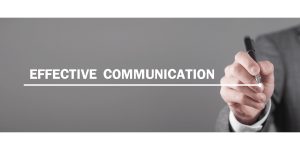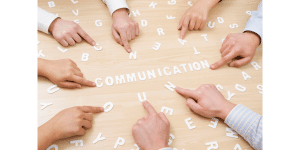Effective communication is the foundation of any successful workplace. It’s the key to building strong relationships with colleagues, fostering a positive work environment, and achieving shared goals. However, effective communication is easier said than done. In today’s fast-paced and constantly evolving workplace, it’s easy to get caught up in daily tasks and forget about the importance of good communication.
Related: How to Improve Leadership Skills
That’s where this article comes in – we’ll explore some practical tips and strategies for building stronger relationships with colleagues through effective communication. Whether you’re a seasoned professional or just starting in your career, these insights will help you become a better communicator and build stronger, more productive relationships with your colleagues. So, let’s dive in and discover how to improve communication in the workplace.
- The Importance of Communication in the Workplace
- Common Communication Challenges in the Workplace
- Tips for Effective Workplace Communication
- Strategies for Building Stronger Relationships with Colleagues
- The Role of Active Listening in Workplace Communication
- The Impact of Nonverbal Communication on Workplace Relationships
- Overcoming Communication Barriers
- Tools and Resources for Improving Workplace Communication
- Case Studies of Successful Workplace Communication
- Conclusion
The Importance of Communication in the Workplace
Communication is the foundation of any successful workplace. It’s the key to building strong relationships with colleagues, fostering a positive work environment, and achieving shared goals. Whether you’re working on a project with a team or trying to resolve a conflict with a colleague, effective communication is essential. Good communication helps to create a sense of trust, respect, and understanding among team members, which in turn leads to better collaboration and more successful outcomes.
However, communication is not just about exchanging information. It’s also about building relationships and creating a positive workplace culture. When team members feel valued and heard, they are more likely to be engaged, motivated, and committed to their work. On the other hand, poor communication can lead to misunderstandings, conflicts, and a lack of trust among colleagues. It can also result in missed deadlines, poor performance, and decreased productivity.
In today’s fast-paced and constantly evolving workplace, effective communication is more important than ever. With remote work becoming increasingly common, team members may be working from different locations and time zones, making communication even more challenging. That’s why it’s essential to develop strong communication skills and build positive relationships with colleagues.
Common Communication Challenges in the Workplace
Despite the importance of good communication, many challenges can get in the way. Some of the most common communication challenges in the workplace include:
1. Misunderstandings
Misunderstandings can occur when team members have different interpretations of a message or when there is a lack of clarity in communication. This can lead to confusion, mistakes, and delays in completing tasks.
2. Lack of Feedback
Feedback is essential for improving performance and achieving shared goals. However, many team members may be reluctant to give or receive feedback, which can lead to missed opportunities for growth and development.
3. Language Barriers
In multicultural workplaces, language barriers can be a significant challenge to effective communication. Colleagues may have different levels of fluency in the language of communication, which can lead to misunderstandings and misinterpretations.
4. Nonverbal Communication
Nonverbal communication plays a significant role in workplace communication. However, it can also be a source of confusion and misinterpretation. For example, a team member’s body language or tone of voice may convey a message that is different from their words.
5. Remote Work
Remote work can make communication even more challenging, as team members may be working from different locations and time zones. This can lead to delays in responding to emails or messages, as well as difficulties in coordinating tasks and projects.
Tips for Effective Workplace Communication
Effective communication is essential for building strong relationships with colleagues and achieving shared goals. Here are some practical tips for improving workplace communication:
1. Be Clear and Concise
When communicating with colleagues, it’s important to be clear and concise. Use simple language and avoid technical jargon or complex terminology. Be specific about what you want to communicate and avoid vague or ambiguous messages.
2. Listen Carefully
Active listening is an essential skill for effective communication. When listening to colleagues, pay attention to their words, tone of voice, and body language. Show that you’re listening by nodding, making eye contact, and asking clarifying questions.
3. Provide Feedback
Feedback is essential for improving performance and achieving shared goals. When providing feedback, be specific about what you liked or didn’t like about a colleague’s work. Be respectful and constructive in your feedback, and offer suggestions for improvement.
4. Use Technology
Technology can be a powerful tool for improving workplace communication. Use email, messaging apps, and video conferencing tools to stay in touch with colleagues, especially when working remotely. However, be mindful of the potential for miscommunication when using technology, and be sure to clarify messages when necessary.
5. Practice Empathy
Empathy is the ability to understand and share the feelings of others. When communicating with colleagues, try to put yourself in their shoes and understand their perspectives. This can help to build trust and foster positive relationships.
Strategies for Building Stronger Relationships with Colleagues
Building strong relationships with colleagues is essential for a positive workplace culture and successful outcomes. Here are some strategies for building stronger relationships through effective communication:
1. Show Appreciation
Showing appreciation for colleagues is a powerful way to build positive relationships. Whether it’s a simple thank you message or a more elaborate gesture, expressing gratitude can help to build trust and foster a positive workplace culture.
2. Collaborate on Projects
Collaborating on projects is an excellent way to build relationships with colleagues. When working together on a task or project, be open to ideas and feedback, and be willing to compromise when necessary. This can help to build trust and respect among team members.
3. Socialize Outside of Work
Socializing outside of work can help to build stronger relationships with colleagues. Whether it’s a team lunch, happy hour, or weekend outing, spending time together outside of work can help to build camaraderie and foster positive relationships.
4. Communicate Openly and Honestly
Open and honest communication is essential for building trust and respect among colleagues. When communicating with colleagues, be truthful and transparent, and avoid withholding information or hiding your feelings. This can help to build stronger relationships and foster a positive workplace culture.
5. Be Flexible
Flexibility is essential for building strong relationships with colleagues. Be willing to adapt to changing circumstances and be open to new ideas and approaches. This can help to build trust and respect among team members and lead to more successful outcomes.
The Role of Active Listening in Workplace Communication
Active listening is an essential skill for effective workplace communication. When listening to colleagues, it’s important to pay attention to their words, tone of voice, and body language. Here are some tips for practising active listening:
1. Pay Attention
When listening to colleagues, it’s essential to pay attention to what they’re saying. Avoid distractions and focus on the person speaking. Use eye contact and facial expressions to show that you’re engaged in the conversation.
2. Ask Questions
Asking questions is an essential part of active listening. Use open-ended questions to encourage colleagues to share their thoughts and feelings. Repeat back what they’ve said to ensure that you’ve understood correctly.
3. Avoid Interrupting
Interrupting colleagues can be disrespectful and disruptive to the conversation. Wait until they’ve finished speaking before responding. If you need to clarify something, wait for a natural pause in the conversation before asking a question.
4. Show Empathy
Empathy is the ability to understand and share the feelings of others. When listening to colleagues, try to put yourself in their shoes and understand their perspectives. This can help to build trust and foster positive relationships.
5. Summarize and Reflect
Summarizing and reflecting on what colleagues have said is an essential part of active listening. Repeat back what they’ve said in your own words to ensure that you’ve understood correctly. Reflect on what they’ve said and respond thoughtfully and respectfully.
The Impact of Nonverbal Communication on Workplace Relationships
Nonverbal communication plays a significant role in workplace communication. Here are some examples of nonverbal communication and their impact on workplace relationships:
1. Body Language
Body language can convey a lot of information about a person’s thoughts and feelings. For example, crossed arms may convey defensiveness or resistance, while open body language may convey openness and receptiveness.
2. Tone of Voice
The tone of voice can also convey a lot of information about a person’s thoughts and feelings. For example, a monotone voice may convey boredom or disinterest, while an enthusiastic voice may convey excitement and engagement.
3. Facial Expressions
Facial expressions can convey a lot of information about a person’s thoughts and feelings. For example, a smile may convey happiness or friendliness, while a frown may convey sadness or disapproval.
4. Eye Contact
Eye contact is an essential part of nonverbal communication. It conveys interest, attention, and respect. Lack of eye contact can convey disinterest, distraction, or discomfort.
5. Gestures
Gestures can also convey a lot of information about a person’s thoughts and feelings. For example, a thumbs-up may convey approval or agreement, while a shaking head may convey disapproval or disagreement.
Overcoming Communication Barriers
Communication barriers can get in the way of effective workplace communication. Here are some strategies for overcoming communication barriers:
1. Use Simple Language
Using simple language can help to overcome language barriers and ensure that messages are understood. Avoid technical jargon or complex terminology, and use clear and concise language.
2. Provide Feedback
Feedback is essential for improving performance and achieving shared goals. When providing feedback, be specific about what you liked or didn’t like about a colleague’s work. Be respectful and constructive in your feedback, and offer suggestions for improvement.
3. Practice Active Listening
Active listening is an essential skill for effective communication. When listening to colleagues, pay attention to their words, tone of voice, and body language. Show that you’re listening by nodding, making eye contact, and asking clarifying questions.
4. Be Open to Feedback
Being open to feedback is essential for growth and development. When receiving feedback, be receptive and open to suggestions for improvement. Avoid getting defensive or dismissive, and be willing to take constructive criticism.
5. Use Technology
Technology can be a powerful tool for overcoming communication barriers. Use email, messaging apps, and video conferencing tools to stay in touch with colleagues, especially when working remotely. However, be mindful of the potential for miscommunication when using technology, and be sure to clarify messages when necessary.
Tools and Resources for Improving Workplace Communication
There are many tools and resources available for improving workplace communication. Here are some examples:
1. Communication Apps
Communication apps like Slack, Microsoft Teams, and Zoom can help to improve workplace communication, especially when working remotely. These apps allow team members to stay in touch, collaborate on projects, and share information easily.
2. Training and Development Programs
Training and development programs can help to improve communication skills and foster positive workplace relationships. Many organizations offer training programs on communication skills, conflict resolution, and other related topics.
3. Coaching and Mentoring
Coaching and mentoring can be powerful tool for improving workplace communication. A coach or mentor can provide feedback, guidance, and support in developing communication skills and building positive relationships with colleagues.
4. Online Resources
There are many online resources available for improving workplace communication, including articles, podcasts, and videos. These resources offer practical tips and strategies for improving communication skills and building positive workplace relationships.
5. Employee Feedback Surveys
Employee feedback surveys can be a valuable tool for improving workplace communication. These surveys allow team members to provide feedback on communication practices, identify areas for improvement, and offer suggestions for change.
Case Studies of Successful Workplace Communication
Effective workplace communication can lead to many positive outcomes, including increased productivity, better collaboration, and stronger relationships with colleagues. Here are some examples of successful workplace communication:
1. Zappos
Zappos, an online shoe and clothing retailer, is known for its strong workplace culture and commitment to customer service. The company emphasizes open and honest communication, with regular town hall meetings and employee feedback sessions. This approach has helped to build a positive workplace culture and foster strong relationships among team members.
2. Patagonia
Patagonia, an outdoor clothing and equipment company, is known for its commitment to environmental sustainability and social responsibility. The company emphasizes transparency and open communication, with regular updates on its environmental and social initiatives. This approach has helped to build a strong sense of trust and respect among team members.
3. Google
Google is known for its innovative workplace culture and commitment to employee engagement. The company emphasizes open communication and collaboration, with regular team meetings and brainstorming sessions. This approach has helped to foster a culture of creativity and innovation among team members.
Conclusion
Effective communication is essential for building strong relationships with colleagues, fostering a positive work environment, and achieving shared goals. In today’s fast-paced and constantly evolving workplace, it’s more important than ever to develop strong communication skills and build positive relationships with colleagues. By using the tips and strategies outlined in this article, you can become a better communicator and build stronger, more productive relationships with your colleagues. Remember, good communication is not just about exchanging information – it’s about building relationships, fostering a positive workplace culture, and achieving shared goals.












